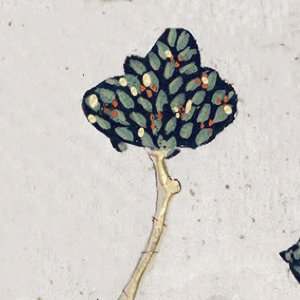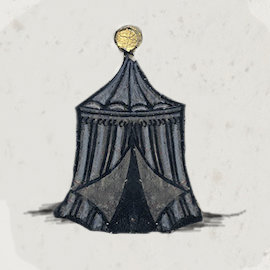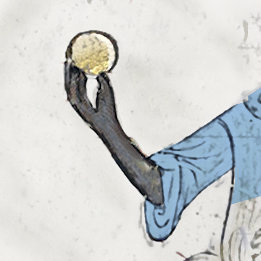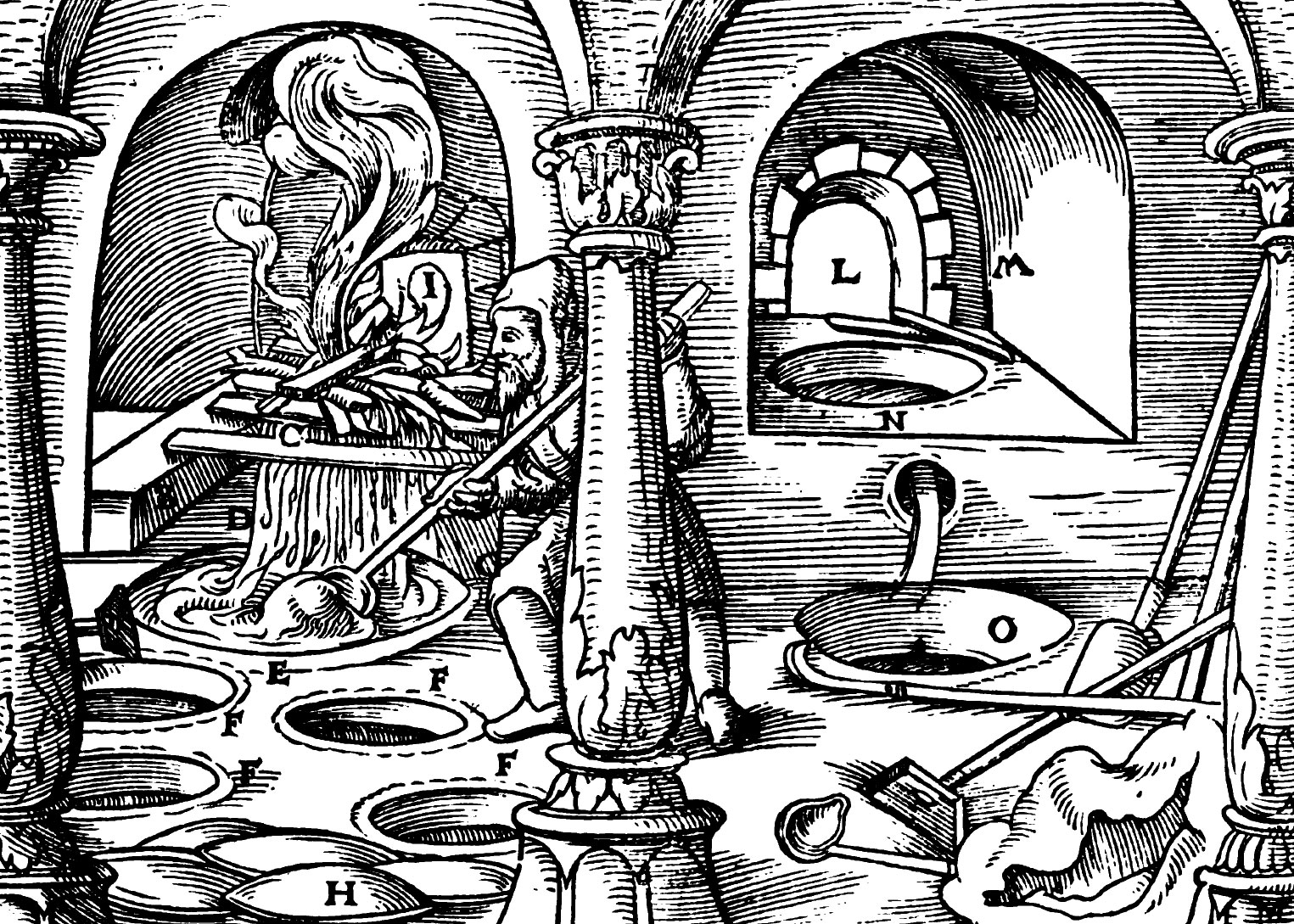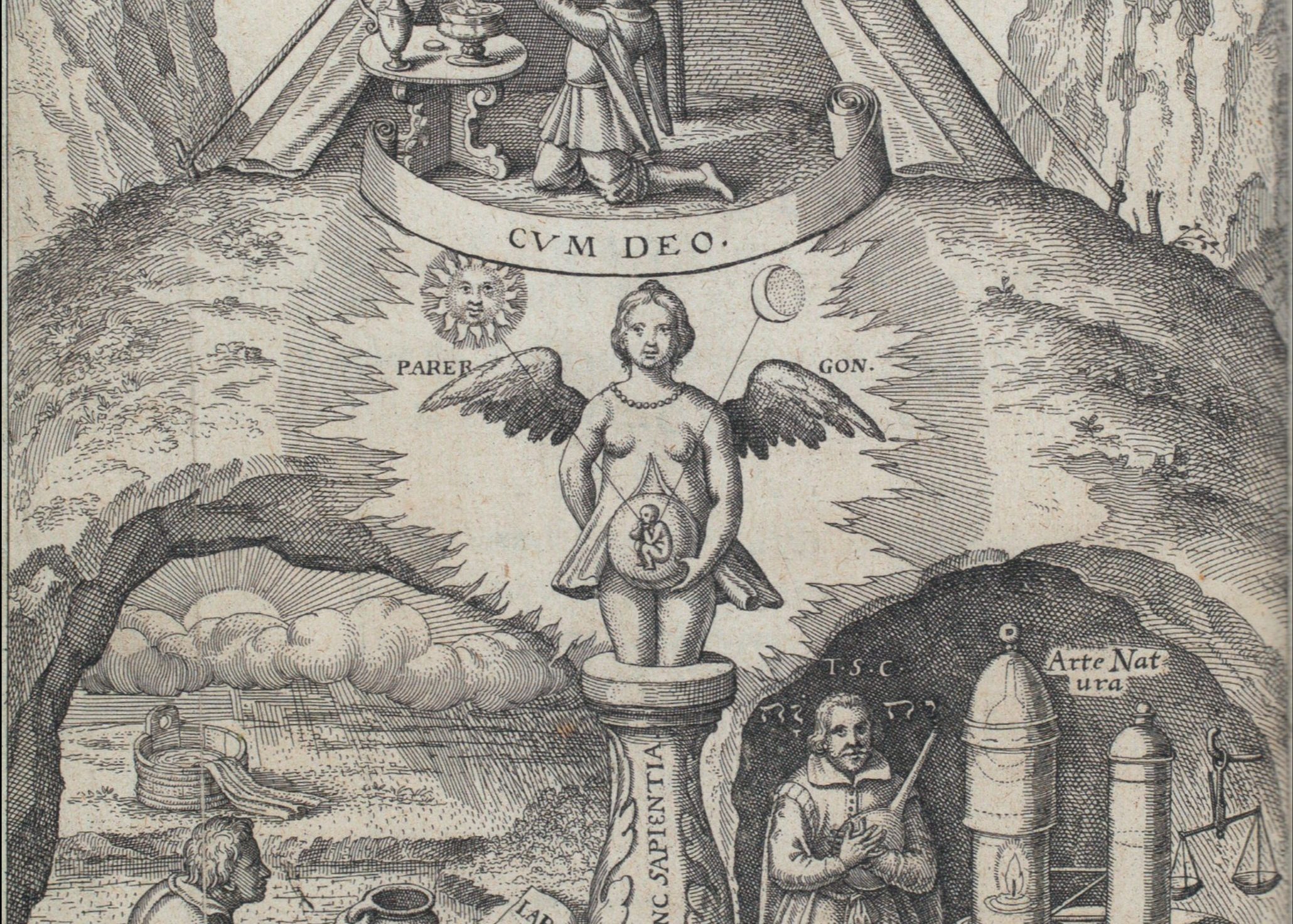How does a recipe, reliably passed down for almost two thousand years, end up muddled and misattributed at the height of the information age? A story involving Papal Inquisitors and Wikipedia editors, American revolutionaries and puzzled magicians...
I recently came across an ancient recipe for an unusual invisible ink. It’s supposed to let you write secret messages underneath the shell of an egg.
The recipe was nestled in a section on chickens in the 10th-century agricultural compendium known as the Geoponica (or Farm Work):
„To make inscriptions on eggs. From Africanus. Grind up oak gall and alum with vinegar until it reaches the thickness of black ink. Use it to write whatever you want on the egg. Once the writing has dried in the sun, place the egg into a sharp brine. Once it has dried, boil it, and when you have peeled it, you will find the inscription.“ Geoponica, 14.10 (roughly 10th century, Africanus’ recipe is originally 3rd century CE), Greek: Ὠὰ κατάγραπτα ποιῆσαι. Ἀφρικανοῦ. Κικίδος καὶ στυπτηρίας μετὰ ὄξους τρίψας, ἕως γένηται πάχος μέλανος, ἐπίγραψον ἐξ αὐτοῦ ὃ θέλεις τῷ ὠῷ, καὶ ψυγείσης τῆς γραφῆς ἐν ἡλίῳ κατάθες τὸ ὠὸν εἰς ἅλμην δριμεῖαν, καὶ ψύξας ἕψησον, καὶ λεπίσας εὑρήσεις τὴν ἐπιγραφήν.
The compiler of the Geoponica attributes the recipe to someone named Africanus, whom scholars typically identify with Sextus Julius Africanus, a Libyan philosopher of the second and third century CE. Africanus was a Christian (before it was popular), spent time in and around Judaea and Rome, exchanged letters with Origen, and wrote a book called Kestoi—an encyclopedic mix of rhetoric, natural philosophy and what he called ‘forbidden investigations’ (ἱστορίαι ἀπόρρητοι).
Looking into this question, I came across Papal inquisitors and Wikipedia editors, American revolutionaries and puzzled magicians—even a cash prize from an American professor for anyone who can get it to work
From the Kestoi (if that’s the original source) the recipe would have been copied into the country-knowledge Compendium of Farming Practices (Συναγωγὴ γεωργικῶν ἐπιτηδευμάτων) compiled by Vindonius Anatolius sometime in the 4th century CE. From there, it would have found its way into a 6th-century work called Selections on Farming (περὶ γεωργίας ἐκλογαί) compiled by Cassianus Bassus, now lost, but a major source for the Geoponica. That’s the story anyway.
But if you try to find anything about Africanus’ recipe online, you’ll notice three things: first, no one can get it to work; second; it’s nearly always missing one of its ingredients, namely oak gall; and third, it’s never attributed to Africanus. Instead, it’s attributed to Giambattista della Porta, the 16th century Italian polymath and author of the Magia Naturalis or Natural Magic.
This left me quite confused. How does a recipe, reliably passed down for almost two thousand years, end up misattributed at the height of the information age? Looking into this question, I came across Papal inquisitors and Wikipedia editors, American revolutionaries and puzzled magicians—even a cash prize from an American professor for anyone who can get it to work. I was also able to see in real time how a moment in history of a text can unalterably change the way we understand the past.
Part I. Giambattista della Porta and the Inquisition
The story of della Porta’s secret-message eggs is an exciting Renaissance tale of inquisitiors and intrigue. Della Porta, no friend of the Catholic Church, needed a way to get messages to his friends imprisoned by the Inquisition. So he did what any scientist would do and invented a technique for writing messages where no one would ever expect: in this case, through the shells and onto the whites of hardboiled eggs. Once delivered as food, the prisoners could read the messages, and then eat the evidence.
The story is often retold on the internet. A few examples can be found here, here and here. It even made it onto his Wikipedia page:

„…eggs are not stopped by the Papal Inquisition and no fraud is suspected to be in them…“
The story may have some truth to it. In chapter four of book sixteen of the Magia Naturalis, della Porta actually writes about ways to hide a secret message in an egg, and at the beginning of the chapter, he says he is including them because they are a good way to get messages past the Inquisitors:
“…eggs are not stopped by the Papal Inquisition and no fraud is suspected to be in them…” Giambattista della Porta, Magia Naturalis 16.4 (Latin 1590, English 1658); Latin: …pontificalium suffragiorium comittiis ova non incipiuntur nec aliquid fraudis in eis suspicatur…
However, there is a big difference in what comes after this. First, della Porta does not take credit for the recipe, instead attributing it to Africanus. Second, he includes vinegar along with the pigment (oak gall) and the alum (a mordant). Third, he says he could not get it to work:
“Africanus teaches thus: ‘grind oak galls and alum with vinegar, until they have the viscosity of ink. With it, inscribe whatever you want on the egg and once the writing has been dried by the sun, place the egg in sharp brine, and having dried it, cook it, peel, and you will find the inscription.’ I put it in vinegar and nothing happened, unless by ‘brine’, he meant sharp lye, what’s normally called capitellum“. Capitellum is a mixture of quicklime and oak ashes. See Magia Naturalis 9.3 where it is used in a black hair dye (English). Giambattista della Porta, Magia Naturalis 16.4, Latin: Africanus ita docet. Gallas et alumen cum aceto terito, donec atramenti spissitudinem habeant, ex hoc quicquid libuerit ouo inscribito, et postquam scriptum Sole desiccatum fuerit, ouum in muriam acrem demittito, et resiccatum coquito, et decorticato, et reperies inscriptionem. Ego in acetum imposui, et nihil evenit, si per muriam non intelligat acre lixiviu, vulgo capitello dictum. Della Porta’s text is nearly a word for word translation of the Greek from the Geoponica, and it is also similar, but not identical, to Cornarius’ 1538 Latin translation of the Geoponica passage.
Despite his failure in replicating it, della Porta found Africanus’ recipe tempting enough that he devised another method to try to get it to work. This one is almost never found online, so I’ll append it at the end. To summarize, he says one should first boil the egg, coat it in wax, and then inscribe the message in the wax through to the shell (as in etching); next, he says to put the egg in a solution of alum and gall (for how long is unclear), followed by a solution of sharp vinegar, after which the egg is dried and the shell removed to find the message in saffron-coloured writing. This also resembles a technique attributed to Africanus. For more, see the recipe in Part III.
I began to wonder how the mistaken attribution first came about, so I clicked on the footnote at the end of the story on Wikipedia. I assumed I’d find something—and I did, just not what I expected. The footnote pointed to page 227 of a 2015 book called Philalethe Reveal’d Vol. 2 B/W, the text of which was almost identical to the Wikipedia article but didn’t include any references. “Captain Nemo” and “Fra’ Cercone”. (2015). Philalethe Reveal’d: The Masterpiece of an English Adept, full uncovered. Vol. 2. Nautilus Editions & Alla via Jacobea Editions, p. 277.
I checked other languages to see if I could find better sources—French, Italian, Spanish and German—but the story didn’t show up in any language version other than English. This made me even more confused. Surely this story didn’t just appear in a 2015 book. And why was it only in English?
It also means the reference in Wikipedia had led me in a circle and I had to start from somewhere else
Wikipedia is great because it preserves the entire edit history for every article on the site. I wanted to find out when the story about the egg was added to see if it might give me some clues to other possible sources. So, I started scrolling through the article history until I found it: a revision on 23 December 2012—three years before the book cited by Wikipedia was published!
In fact, whoever it was who added the story (looks to have been someone interested in British art and museum collections in London, UK) didn’t give a reference, and the story sat there, unnoticed, until March 2015, when someone added a note: “[citation needed]”. The request remained unfulfilled for almost two years until February 2017, when the reference to Philalethe Reveal’d was added.
This means the story was on Wikipedia for five years before the reference was added—long enough for the authors of Philalethe Reveal’d to take the story from the Wiki, include it in their book, publish it, and for someone else to search for the story on Google, find the version in the book, and add it as a citation to the Wikipedia article that it copied in the first place.
It also means the reference in Wikipedia had led me in a circle and I had to start from somewhere else. And since some of the websites I looked into besides Wikipedia mentioned a book on invisible inks by Kristie Macrakis, a professor at Georgia Tech, I made fresh start from there.
Part II. The Gall
In her 2014 book, Prisoners, Lovers, and Spies: The Story of Invisible Ink from Herodotus to Al-Qaeda, Kristie Macrakis mentions the story of della Porta and the egg as an example of steganography, the art of hiding messages in other messages or objects. Macrakis offers a similar, if slightly more embellished, version of the story to the one found on Wikipedia. And like Philalethe Reveal’d, her book came out around two years after the Wiki story appeared, so I wondered if Macrakis’ version might also be a Wiki-descendent.
I found, however, that there is reason to think that her version and the Wikipedia version are not so closely related. While both of them leave ingredients out of Africanus’ original, the ingredients they leave out are different. The Wiki leaves out the vinegar. Macrakis leaves out oak gall.

Oak galls are round fleshy growths found on oak trees, caused when a gall wasp lays an egg on a leaf bud. The precise mechanism is still unknown, but somehow the gall grows around and protects the egg and then the larva as it grows. The larva feeds on the tissue until adulthood, at which point it bores its way out leaving a distinctive, perfectly circular hole in the gall. Galls were originally used in tanning leather, but have been used in the production of inks since at least Late Antiquity. The high concentration of tannins in the oak gall make it perfect for inks: tannins form stable pigments that have been in use for thousands of years (medieval manuscripts are mostly written in iron gall ink). Alum, on the other hand, is not a pigment but a mordant: something that helps a pigment bind to its substrate.
…how could the recipe work without oak gall as a pigment?
The version of the recipe in Macrakis’ book is missing this key ingredient: the oak gall. But it’s not just Macrakis. The version of the recipe that includes only alum and vinegar is the one that’s found all over the place, on the internet and in print. This is hard to understand: how could the recipe work without oak gall as a pigment?
This has already been pointed out a few times online (here’s a comment from a thread on reddit; and here’s a post by magician Craig Matsuoka in a magician’s forum, who correctly points out that della Porta says he is debunking Africanus, although he does not follow it up). But it seems more likely that people came to this conclusion after reading the Wiki (or its ancestor) rather than by reading della Porta, since people mostly talk about it needing a “pigment” rather than “oak gall”. Still, they are right: alum on its own would not stain anything.
It comes as no surprise, therefore, when Macrakis reports that she and colour chemist Jason Lye could not get the recipe to work. She describes their attempts and frustration in her book and in a video posted to YouTube. Frustrated but not giving up, she asks anyone who has managed to get it to work to get in touch with her. Macrakis, K. (2014). Prisoners, Lovers, and Spies: The Story of Invisible Ink from Herodotus to Al-Qaeda. United Kingdom: Yale University Press, p. 311. Her website even increases the stakes: she offers a $200 prize to anyone who has done it and can show how they did it.
But if the version of the recipe without oak gall doesn’t work, how did it end up becoming so common? Macrakis cites a source that suggests it dropped out some time ago. In a New York Times article from May 1965, it’s reported that the United States Department of Agriculture encouraged parents to get children to eat more eggs by teaching them to write secret messages on the inside using a ‘magic ink.’ The ink’s ingredients: vinegar and alum.

No doubt building on the popularity of ‘60s spy toys, they told kids to mix one ounce of alum with one cup of vinegar, then use the colorless magic ink to write a message on the shell of an uncooked egg. Once it was dry, one only had to boil the egg for 15 minutes, and—so the USDA promised—whatever secret was written on the shell would show up inside on the white of the boiled egg.
I have kept digging and found a few more leads that may be the USDA’s source, some dating back to the turn of the 20th century (more on this story here). All of them are missing the oak gall. How it dropped out is still a mystery.
For now, here are Africanus’ and della Porta’s recipes for writing messages in eggs. I tried to replicate Africanus’ version, with and without oak gall. Like della Porta, I couldn’t get it to work. Maybe you’ll have better luck.
Part III. The Recipes and the Replication
Julius Africanus’ recipe for leaving a secret message in an egg
“To make inscriptions on eggs. From Africanus.
“Grind up oak gall and alum with vinegar until it reaches the thickness of black ink. Use it to write whatever you want on the egg. Once the writing has dried in the sun, place the egg into a sharp brine. Once it has dried, boil it, and when you have peeled it, you will find the inscription.
“If you coat the egg all over with wax and inscribe it until the shell appears through the letters, then leave it to soak in vinegar overnight, on the next day, after removing the wax, you will find that the vinegar has made the outline of the letters transparent.” Geoponica 14.10 (roughly 10th century, originally 3rd century CE). Greek: Ὠὰ κατάγραπτα ποιῆσαι. Ἀφρικανοῦ. Κικίδος καὶ στυπτηρίας μετὰ ὄξους τρίψας, ἕως γένηται πάχος μέλανος, ἐπίγραψον ἐξ αὐτοῦ ὃ θέλεις τῷ ὠῷ, καὶ ψυγείσης τῆς γραφῆς ἐν ἡλίῳ κατάθες τὸ ὠὸν εἰς ἅλμην δριμεῖαν, καὶ ψύξας ἕψησον, καὶ λεπίσας εὑρήσεις τὴν ἐπιγραφήν. Εἰ δὲ κηρῷ περιπλάσας τὸ ὠὸν ἐπιγράψεις ἄχρις ἂν φανῇ τὸ ἔλυτρον τοῖς γράμμασιν, εἶτα ἐάσεις ὄξει βρέχεσθαι τὴν νύκτα, τῇ ἑξῆς περιελὼν τὸν κηρόν, εὑρήσεις τῶν γραμμάτων τὸν τύπον ὑπὸ τοῦ ὄξους γενόμενον διαφανῆ.
Giambattista della Porta’s Recipe
“To make golden letters appear on an egg white, and better when the egg is cooked. Boil an egg hard, roll it in wax, and engrave the letters on the wax with an iron point, so that the marks go through. Place it into a solution of powdered alum and oak galls. Then put it into sharp vinegar, and they will penetrate. And taking of the shells, you shall see them in the white of the egg. Africanus teaches in this way: ‘grind oak galls and alum with vinegar, until they have the viscosity of ink. With it, inscribe whatever your want on the egg and once the writing has been dried by the sun, place the egg in sharp brine, and having dried it, cook it, peel, and you will find the inscription.’ I put it in vinegar and nothing happened, unless by ‘brine’, he meant sharp lye, what’s normally called capitellum.” Giambattista della Porta, Magia Naturalis 16.4, 1590 (English, 1658). Latin: Si vis autem ut litera supra albumen videantur croceae et rectius, ubi ovum excoctum fuerit: Coque ovum donec durescat et cera obline et insculpe literas stylo, ut liturae dehiscent, imponatur in humore, id est, ex gallis cum alumine tritis. Inde acri aceto impones et eae fient pentrabiles, quas cortice, detecto videbis in albumine ovi. Africanus ita docet. Gallas et alumen cum aceto terito, donec atramenti spissitudinem habeant, ex hoc quicquid libuerit ouo inscribito, et postquam scriptum Sole desiccatum fuerit, ouum in muriam acrem demittito, et resiccatum coquito, et decorticato, et reperies inscriptionem. Ego in acetum imposui, et nihil evenit, si per muriam non intelligat acre lixiviu, vulgo capitello dictum.
The Replication
(Click on the images for full pictures)
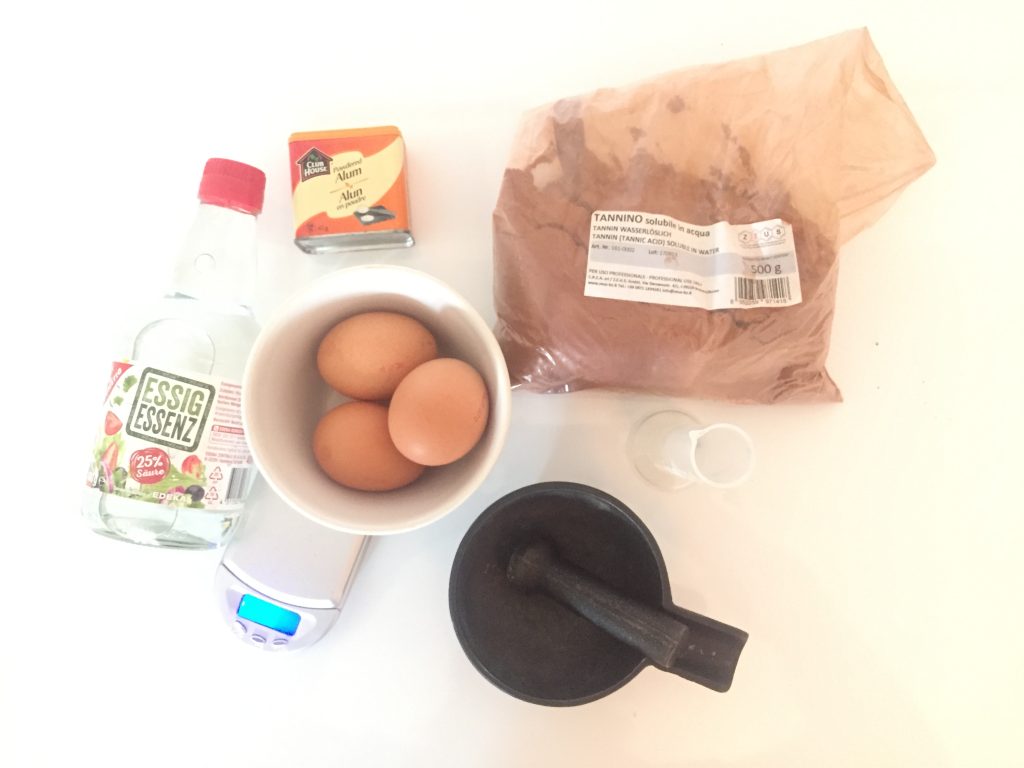
Figure 3.1: The Ingredients. Clockwise from left: vinegar (~25%), alum (potassium aluminium sulphate dodecahydrate, KAl(SO4)2·12H2O), tannin powder (in place of oak gall), graduate cylinder, mortar and pestle, eggs, scale. 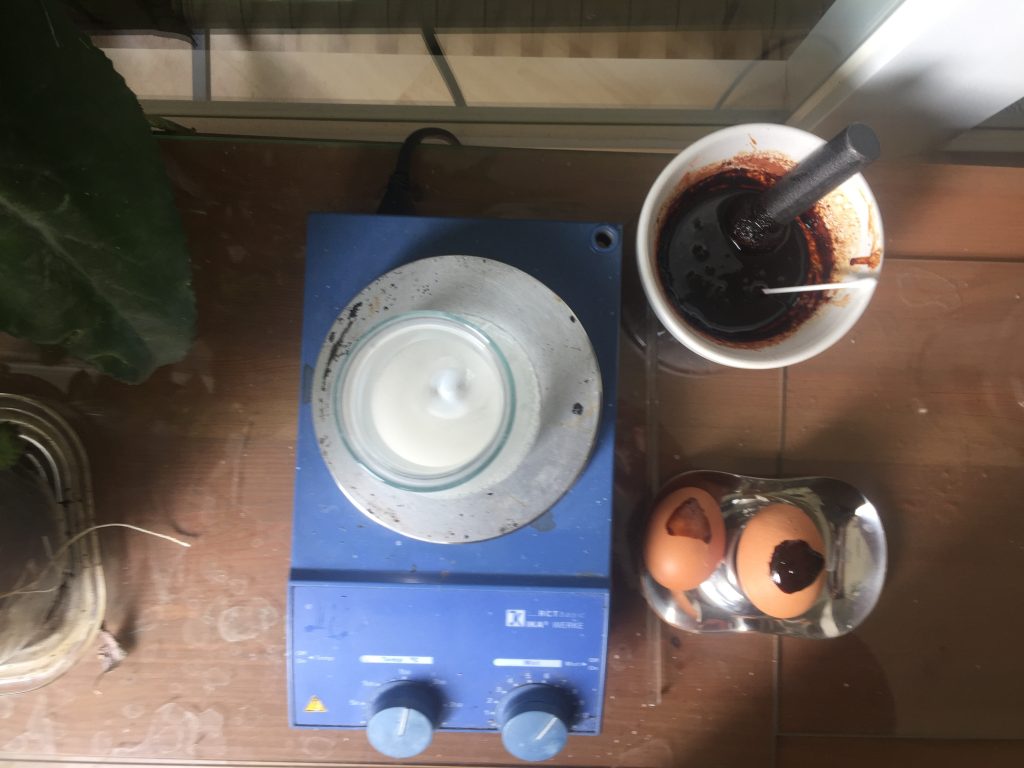
Figure 3.2: Mixing the Ink and Inscribing. I decided not to be too subtle with the designs. I painted the shell with a 1:1:1 mix of tannin powder, alum and vinegar (15g each). I also prepared a 1:1 alum+vinegar control, which I painted on the back side of each egg. I also ran a hard-boiled egg control using both the alum+vinegar+tannin and the alum+vinegar mixtures. 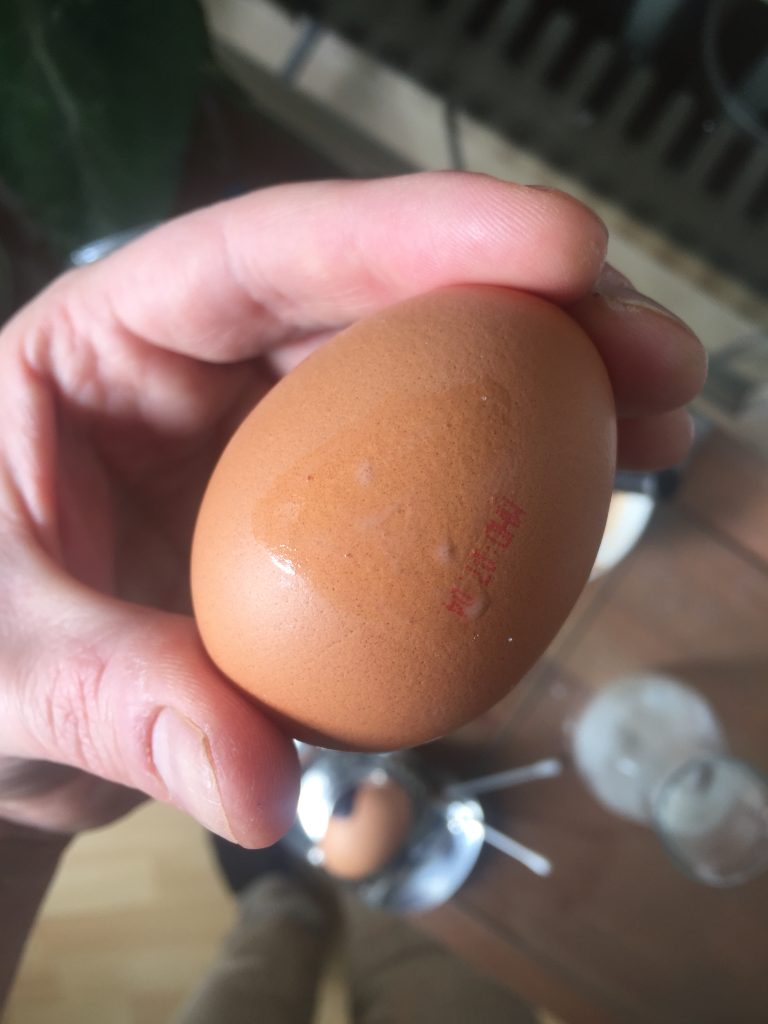
Figure 3.3: Alum + vinegar control. This alum and vinegar dissolves the shell quite quickly. 
Figure 3.4: Drying in the sunshine. The sun doesn’t come to Berlin until sometime in May, so I’ve used a UV light at about 15cm for 30 minutes on each side of the eggs. 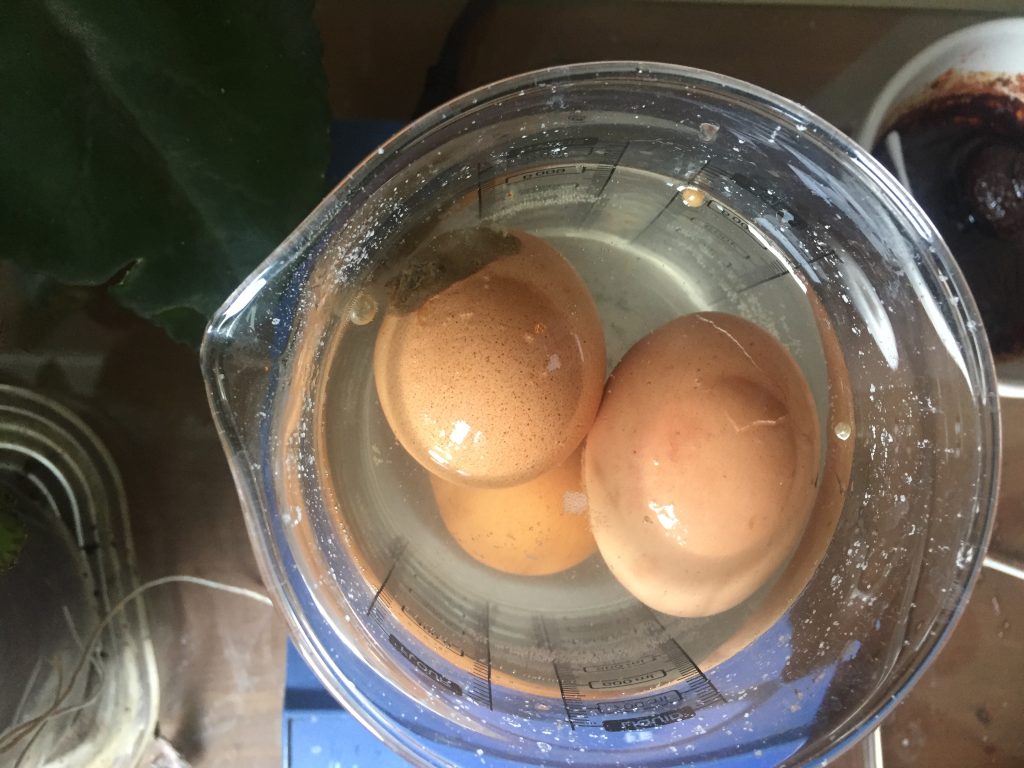
Figure 3.5: Placing the eggs in sharp brine. I dissolved 90g of sea salt in tap water to a final volume of 500ml. I’m not sure what a sharp brine is, but in this replication it just means ‘really salty’. 
Figure 3.6: Drying. Here the eggs are drying before being boiled. 
Figure 3.7: Boiling the eggs. I boiled the eggs that were painted while raw. 
Figure 3.8: The First Disappointment. Here is the egg that was pre-boiled. This is the side that had the vinegar+alum+tannin mixture. Nothing came through. I feel like della Porta. 
Figure 3.9: Close up of the inside of the shell. Here is the egg with the circle shape drawn on. No ink permeated at all through the shell. I read somewhere that eggs are treated with an oil prior to distribution. Maybe something is interfering. 
Figure 3.10: The Second Disappointment. Here is a photograph halfway through removing the shell. This shows quite clearly that it didn’t work. 
Figure 3.11: The Boiled Egg Results. Here are the boiled eggs again. I got excited seeing that yellow on the one egg on the left, but it was just the yolk. 
Figure 3.12: Control: Painting Directly on the Egg White. After peeling the eggs, I decided I wanted to see if the solutions would stain the egg white at all. I painted both solutions, vinegar + alum + tannin and vinegar + alum, onto the cooked egg white and then washed it off. 
Figure 3.13: Control: Painting Directly on the Egg White. The egg white on the left is painted with vinegar + alum + tannin. The egg white on the right is painted with vinegar + alum. I let them sit until dry-ish, about 5 minutes. 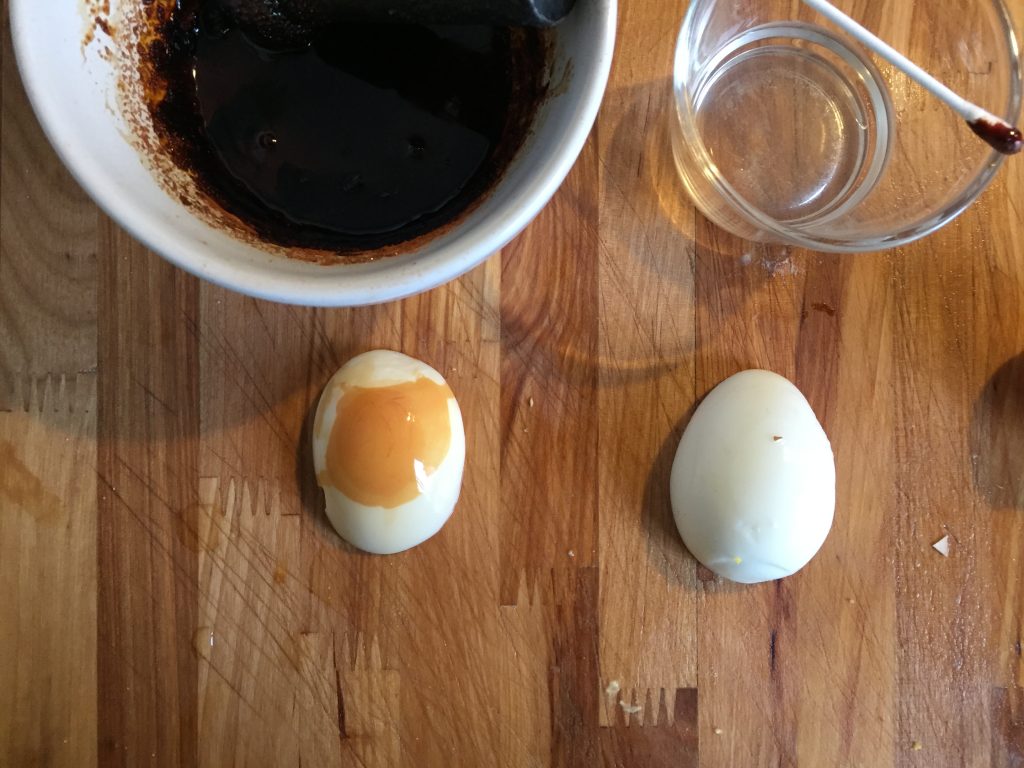
Figure 3.14: Control: Washing off the Inks. Here they are after washing. Only the solution with tannin produced a stain (left). This gives some reason to think the recipe going around the internet simply won’t work, unless there’s some other reagent I’m missing, perhaps something in the uncooked eggs or in iron or bronze pans or something else. 
Figure 3.15: To be continued. I cheated here: I wrote this directly onto the egg white. I will have to try this again once I have collected some oak galls and found some fresh eggs.
This article is part of the blog series Stoffe.
Sean Coughlin is Junior Star Research Fellow at the Institute of Philosophy and Associate Scientist at the Institute of Organic Chemistry and Biochemistry at the Czech Academy of Sciences in Prague.
